Human Resource Management: Recruitment Source Analysis and Evaluation
VerifiedAdded on 2019/12/03
|13
|2941
|142
Report
AI Summary
This report provides a detailed analysis of recruitment sources within the field of Human Resource Management (HRM). It begins with an abstract that emphasizes the crucial role of recruitment in selecting qualified candidates and highlights the influence of factors like employment conditions and expansion plans. The report then delves into the significance of job analysis, defining its role in identifying job duties and requirements, followed by a critical review of both internal and external recruitment methods. Internal sources, including transfers, promotions, and employee referrals, are examined, along with their associated advantages, such as increased employee morale and reduced training needs, and disadvantages, such as limited innovation and potential for favoritism. External sources, such as public advertisements, campus recruitment, and management consultants, are also evaluated, considering their benefits, like introducing fresh perspectives, and drawbacks, like increased time and cost. The report concludes by emphasizing the importance of selecting recruitment sources based on specific organizational needs and conditions, acknowledging the inherent pros and cons of each approach.
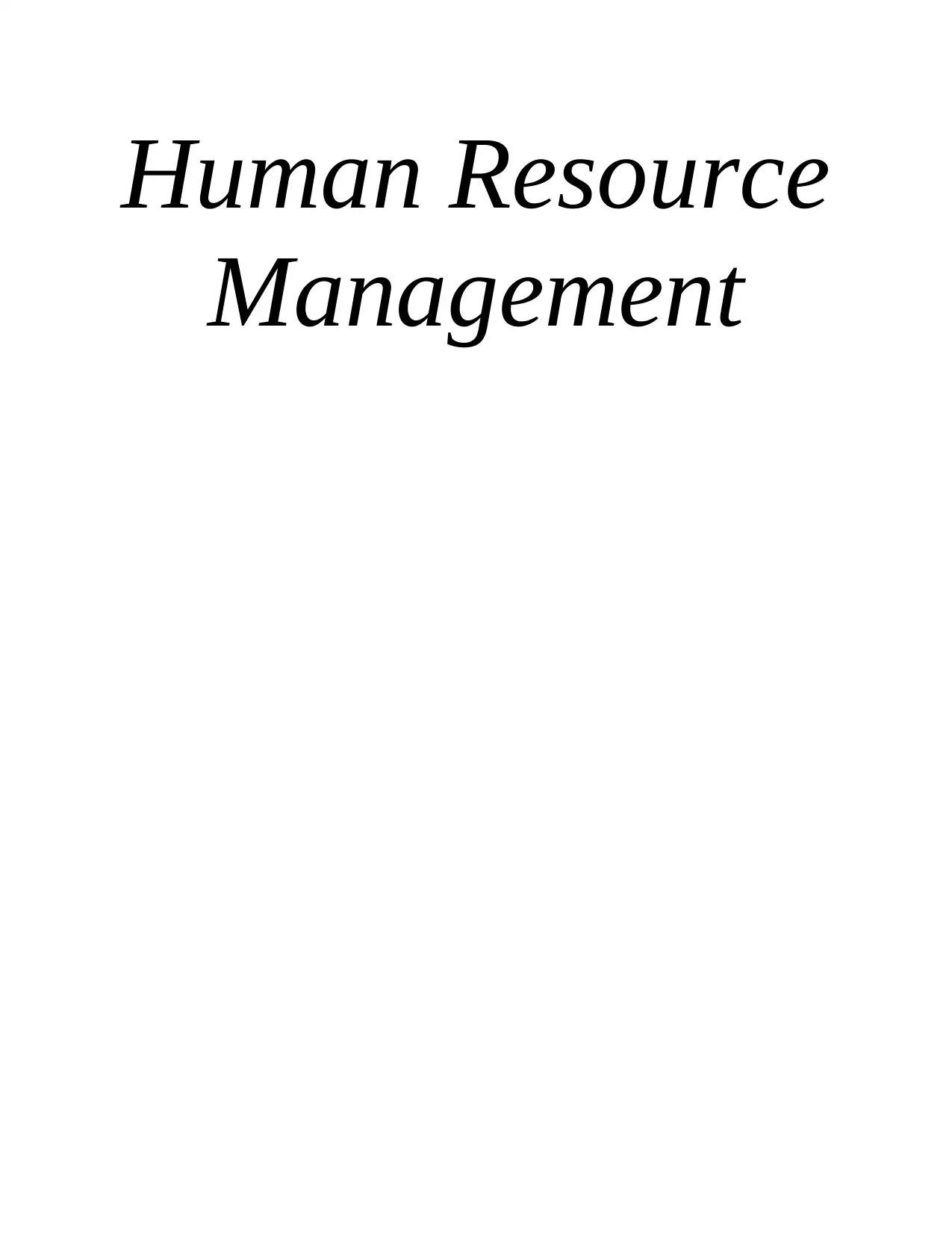
Human Resource
Management
Management
Paraphrase This Document
Need a fresh take? Get an instant paraphrase of this document with our AI Paraphraser
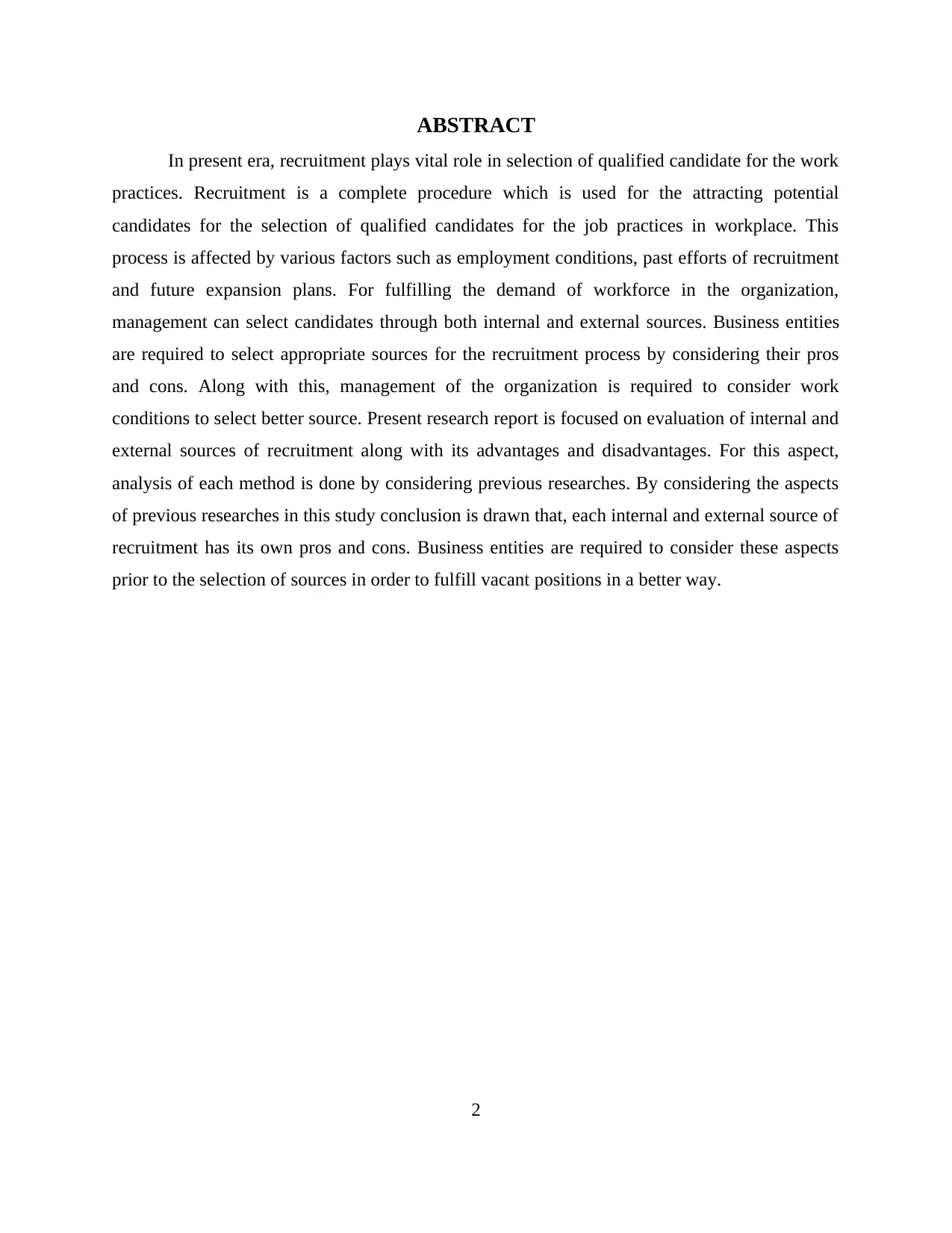
ABSTRACT
In present era, recruitment plays vital role in selection of qualified candidate for the work
practices. Recruitment is a complete procedure which is used for the attracting potential
candidates for the selection of qualified candidates for the job practices in workplace. This
process is affected by various factors such as employment conditions, past efforts of recruitment
and future expansion plans. For fulfilling the demand of workforce in the organization,
management can select candidates through both internal and external sources. Business entities
are required to select appropriate sources for the recruitment process by considering their pros
and cons. Along with this, management of the organization is required to consider work
conditions to select better source. Present research report is focused on evaluation of internal and
external sources of recruitment along with its advantages and disadvantages. For this aspect,
analysis of each method is done by considering previous researches. By considering the aspects
of previous researches in this study conclusion is drawn that, each internal and external source of
recruitment has its own pros and cons. Business entities are required to consider these aspects
prior to the selection of sources in order to fulfill vacant positions in a better way.
2
In present era, recruitment plays vital role in selection of qualified candidate for the work
practices. Recruitment is a complete procedure which is used for the attracting potential
candidates for the selection of qualified candidates for the job practices in workplace. This
process is affected by various factors such as employment conditions, past efforts of recruitment
and future expansion plans. For fulfilling the demand of workforce in the organization,
management can select candidates through both internal and external sources. Business entities
are required to select appropriate sources for the recruitment process by considering their pros
and cons. Along with this, management of the organization is required to consider work
conditions to select better source. Present research report is focused on evaluation of internal and
external sources of recruitment along with its advantages and disadvantages. For this aspect,
analysis of each method is done by considering previous researches. By considering the aspects
of previous researches in this study conclusion is drawn that, each internal and external source of
recruitment has its own pros and cons. Business entities are required to consider these aspects
prior to the selection of sources in order to fulfill vacant positions in a better way.
2
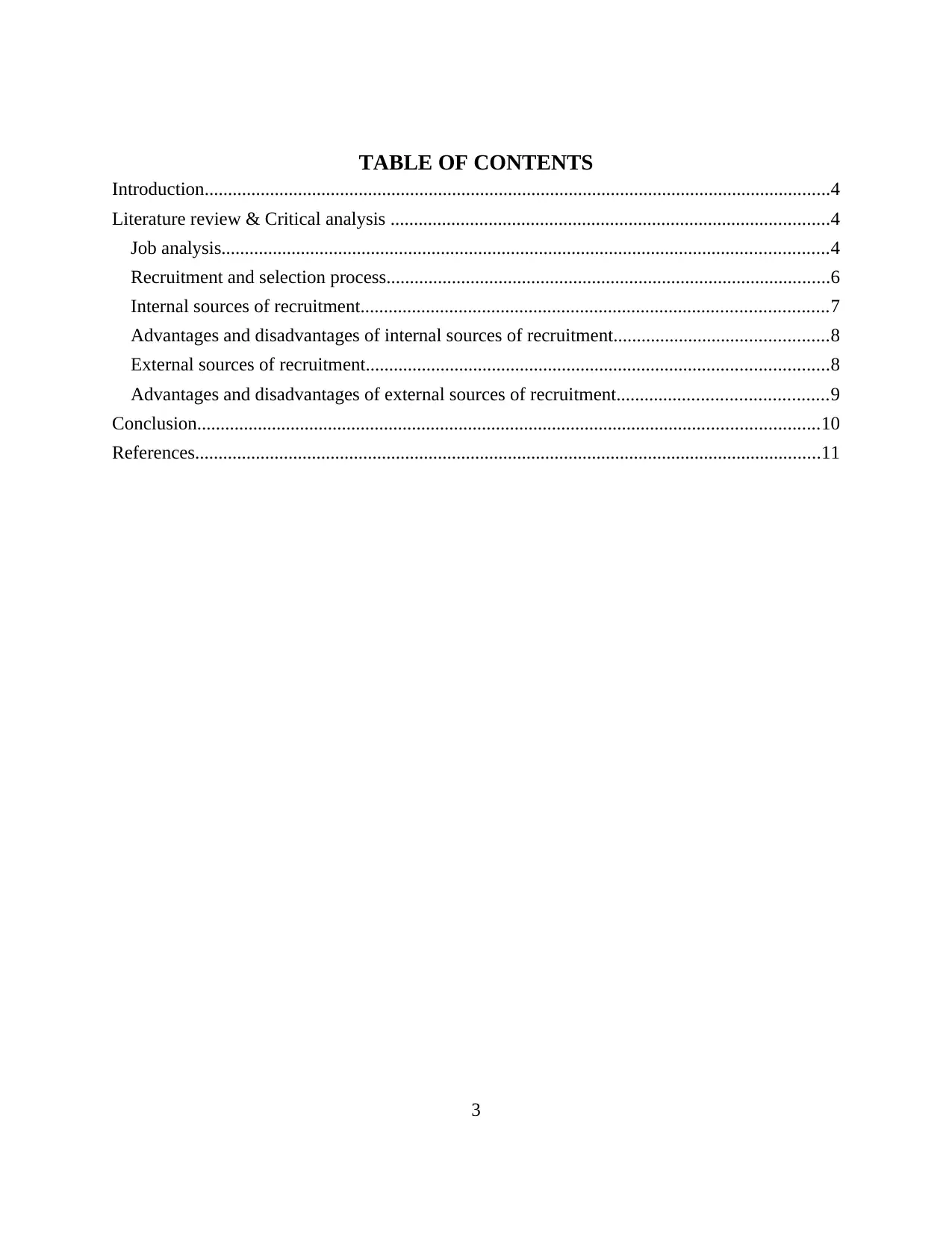
TABLE OF CONTENTS
Introduction......................................................................................................................................4
Literature review & Critical analysis ..............................................................................................4
Job analysis..................................................................................................................................4
Recruitment and selection process...............................................................................................6
Internal sources of recruitment....................................................................................................7
Advantages and disadvantages of internal sources of recruitment..............................................8
External sources of recruitment...................................................................................................8
Advantages and disadvantages of external sources of recruitment.............................................9
Conclusion.....................................................................................................................................10
References......................................................................................................................................11
3
Introduction......................................................................................................................................4
Literature review & Critical analysis ..............................................................................................4
Job analysis..................................................................................................................................4
Recruitment and selection process...............................................................................................6
Internal sources of recruitment....................................................................................................7
Advantages and disadvantages of internal sources of recruitment..............................................8
External sources of recruitment...................................................................................................8
Advantages and disadvantages of external sources of recruitment.............................................9
Conclusion.....................................................................................................................................10
References......................................................................................................................................11
3
You're viewing a preview
Unlock full access by subscribing today!

ILLUSTRATION INDEX
Illustration 1: Job analysis...............................................................................................................8
Illustration 2: Sources of recruitment..............................................................................................9
4
Illustration 1: Job analysis...............................................................................................................8
Illustration 2: Sources of recruitment..............................................................................................9
4
Paraphrase This Document
Need a fresh take? Get an instant paraphrase of this document with our AI Paraphraser
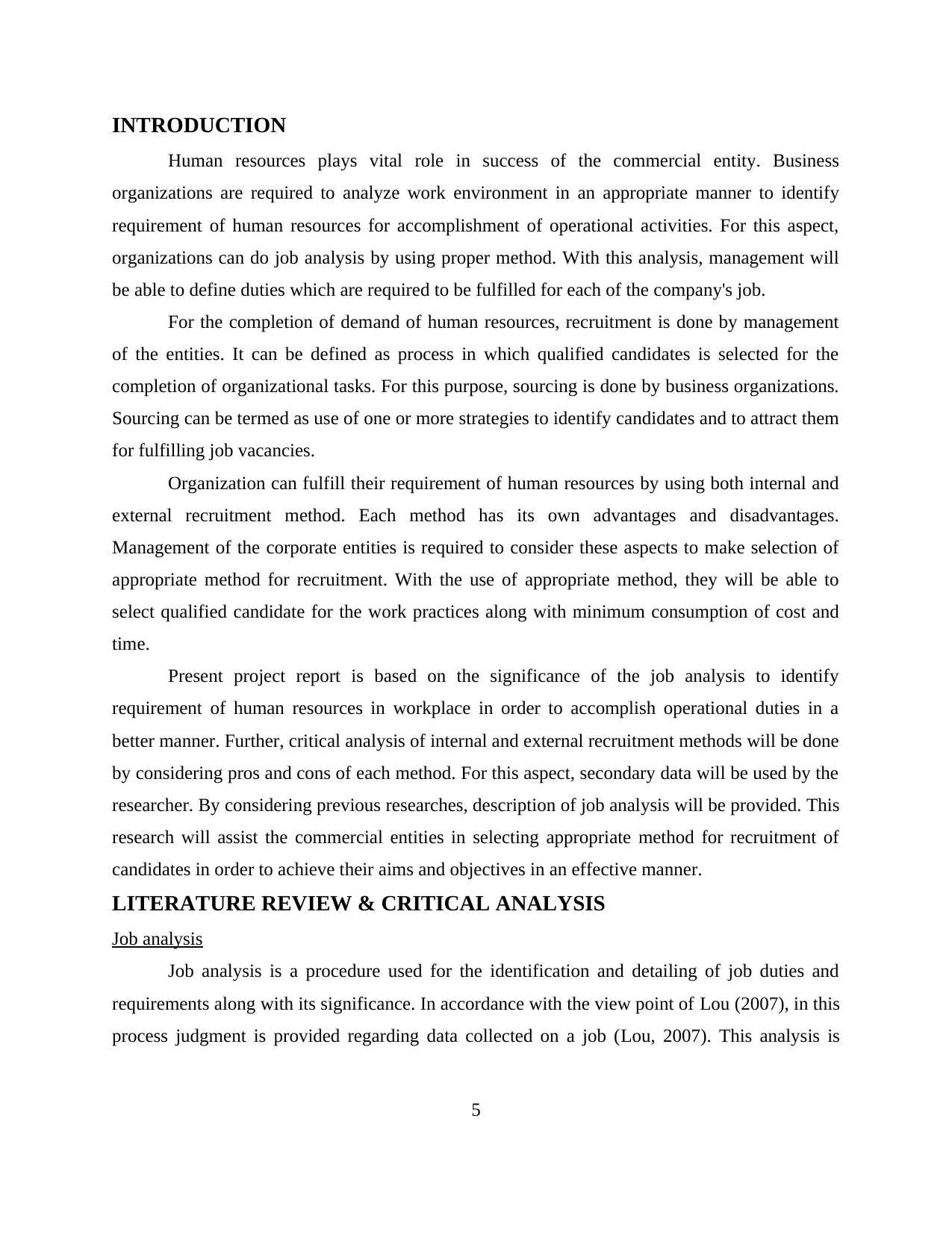
INTRODUCTION
Human resources plays vital role in success of the commercial entity. Business
organizations are required to analyze work environment in an appropriate manner to identify
requirement of human resources for accomplishment of operational activities. For this aspect,
organizations can do job analysis by using proper method. With this analysis, management will
be able to define duties which are required to be fulfilled for each of the company's job.
For the completion of demand of human resources, recruitment is done by management
of the entities. It can be defined as process in which qualified candidates is selected for the
completion of organizational tasks. For this purpose, sourcing is done by business organizations.
Sourcing can be termed as use of one or more strategies to identify candidates and to attract them
for fulfilling job vacancies.
Organization can fulfill their requirement of human resources by using both internal and
external recruitment method. Each method has its own advantages and disadvantages.
Management of the corporate entities is required to consider these aspects to make selection of
appropriate method for recruitment. With the use of appropriate method, they will be able to
select qualified candidate for the work practices along with minimum consumption of cost and
time.
Present project report is based on the significance of the job analysis to identify
requirement of human resources in workplace in order to accomplish operational duties in a
better manner. Further, critical analysis of internal and external recruitment methods will be done
by considering pros and cons of each method. For this aspect, secondary data will be used by the
researcher. By considering previous researches, description of job analysis will be provided. This
research will assist the commercial entities in selecting appropriate method for recruitment of
candidates in order to achieve their aims and objectives in an effective manner.
LITERATURE REVIEW & CRITICAL ANALYSIS
Job analysis
Job analysis is a procedure used for the identification and detailing of job duties and
requirements along with its significance. In accordance with the view point of Lou (2007), in this
process judgment is provided regarding data collected on a job (Lou, 2007). This analysis is
5
Human resources plays vital role in success of the commercial entity. Business
organizations are required to analyze work environment in an appropriate manner to identify
requirement of human resources for accomplishment of operational activities. For this aspect,
organizations can do job analysis by using proper method. With this analysis, management will
be able to define duties which are required to be fulfilled for each of the company's job.
For the completion of demand of human resources, recruitment is done by management
of the entities. It can be defined as process in which qualified candidates is selected for the
completion of organizational tasks. For this purpose, sourcing is done by business organizations.
Sourcing can be termed as use of one or more strategies to identify candidates and to attract them
for fulfilling job vacancies.
Organization can fulfill their requirement of human resources by using both internal and
external recruitment method. Each method has its own advantages and disadvantages.
Management of the corporate entities is required to consider these aspects to make selection of
appropriate method for recruitment. With the use of appropriate method, they will be able to
select qualified candidate for the work practices along with minimum consumption of cost and
time.
Present project report is based on the significance of the job analysis to identify
requirement of human resources in workplace in order to accomplish operational duties in a
better manner. Further, critical analysis of internal and external recruitment methods will be done
by considering pros and cons of each method. For this aspect, secondary data will be used by the
researcher. By considering previous researches, description of job analysis will be provided. This
research will assist the commercial entities in selecting appropriate method for recruitment of
candidates in order to achieve their aims and objectives in an effective manner.
LITERATURE REVIEW & CRITICAL ANALYSIS
Job analysis
Job analysis is a procedure used for the identification and detailing of job duties and
requirements along with its significance. In accordance with the view point of Lou (2007), in this
process judgment is provided regarding data collected on a job (Lou, 2007). This analysis is
5
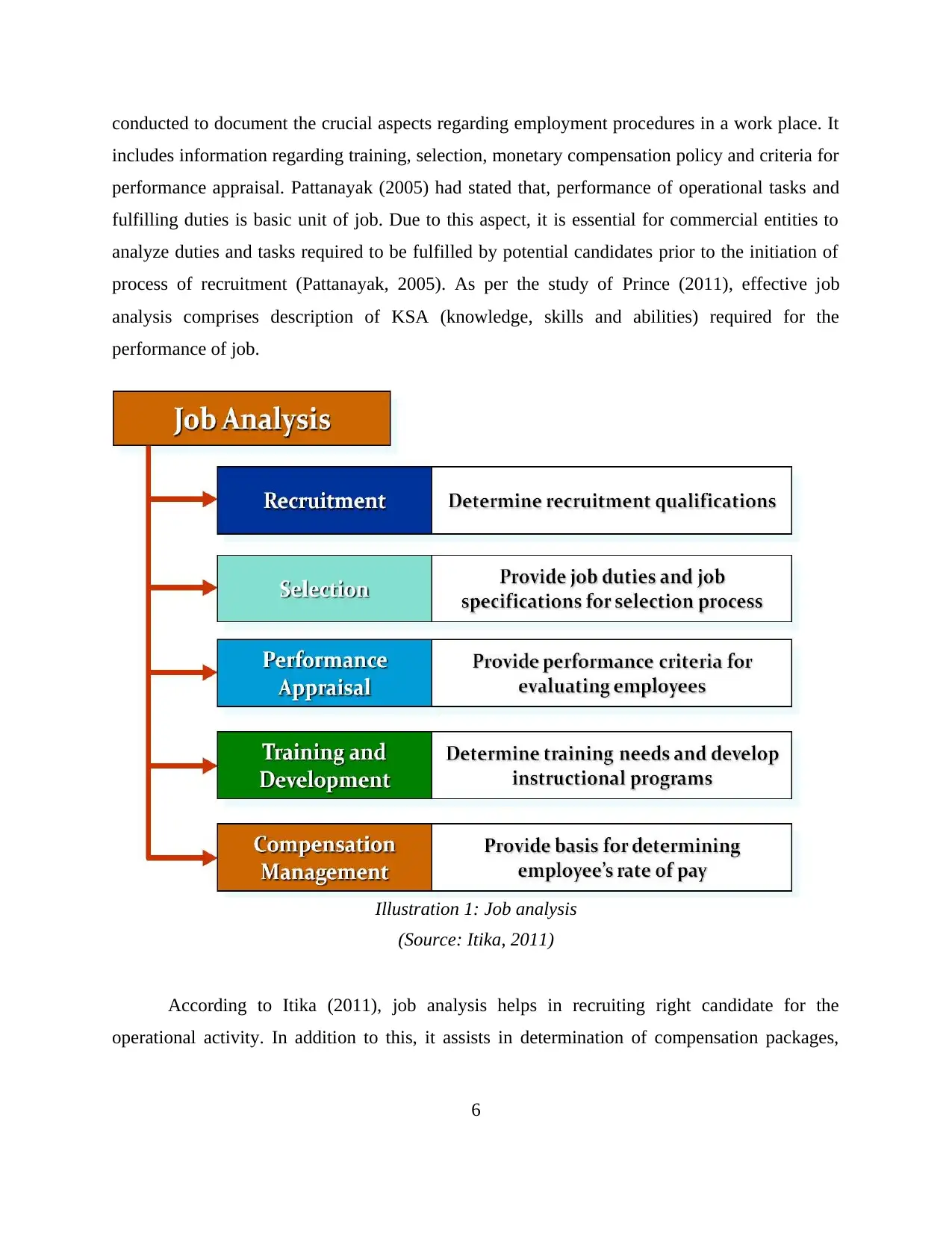
conducted to document the crucial aspects regarding employment procedures in a work place. It
includes information regarding training, selection, monetary compensation policy and criteria for
performance appraisal. Pattanayak (2005) had stated that, performance of operational tasks and
fulfilling duties is basic unit of job. Due to this aspect, it is essential for commercial entities to
analyze duties and tasks required to be fulfilled by potential candidates prior to the initiation of
process of recruitment (Pattanayak, 2005). As per the study of Prince (2011), effective job
analysis comprises description of KSA (knowledge, skills and abilities) required for the
performance of job.
According to Itika (2011), job analysis helps in recruiting right candidate for the
operational activity. In addition to this, it assists in determination of compensation packages,
6
Illustration 1: Job analysis
(Source: Itika, 2011)
includes information regarding training, selection, monetary compensation policy and criteria for
performance appraisal. Pattanayak (2005) had stated that, performance of operational tasks and
fulfilling duties is basic unit of job. Due to this aspect, it is essential for commercial entities to
analyze duties and tasks required to be fulfilled by potential candidates prior to the initiation of
process of recruitment (Pattanayak, 2005). As per the study of Prince (2011), effective job
analysis comprises description of KSA (knowledge, skills and abilities) required for the
performance of job.
According to Itika (2011), job analysis helps in recruiting right candidate for the
operational activity. In addition to this, it assists in determination of compensation packages,
6
Illustration 1: Job analysis
(Source: Itika, 2011)
You're viewing a preview
Unlock full access by subscribing today!
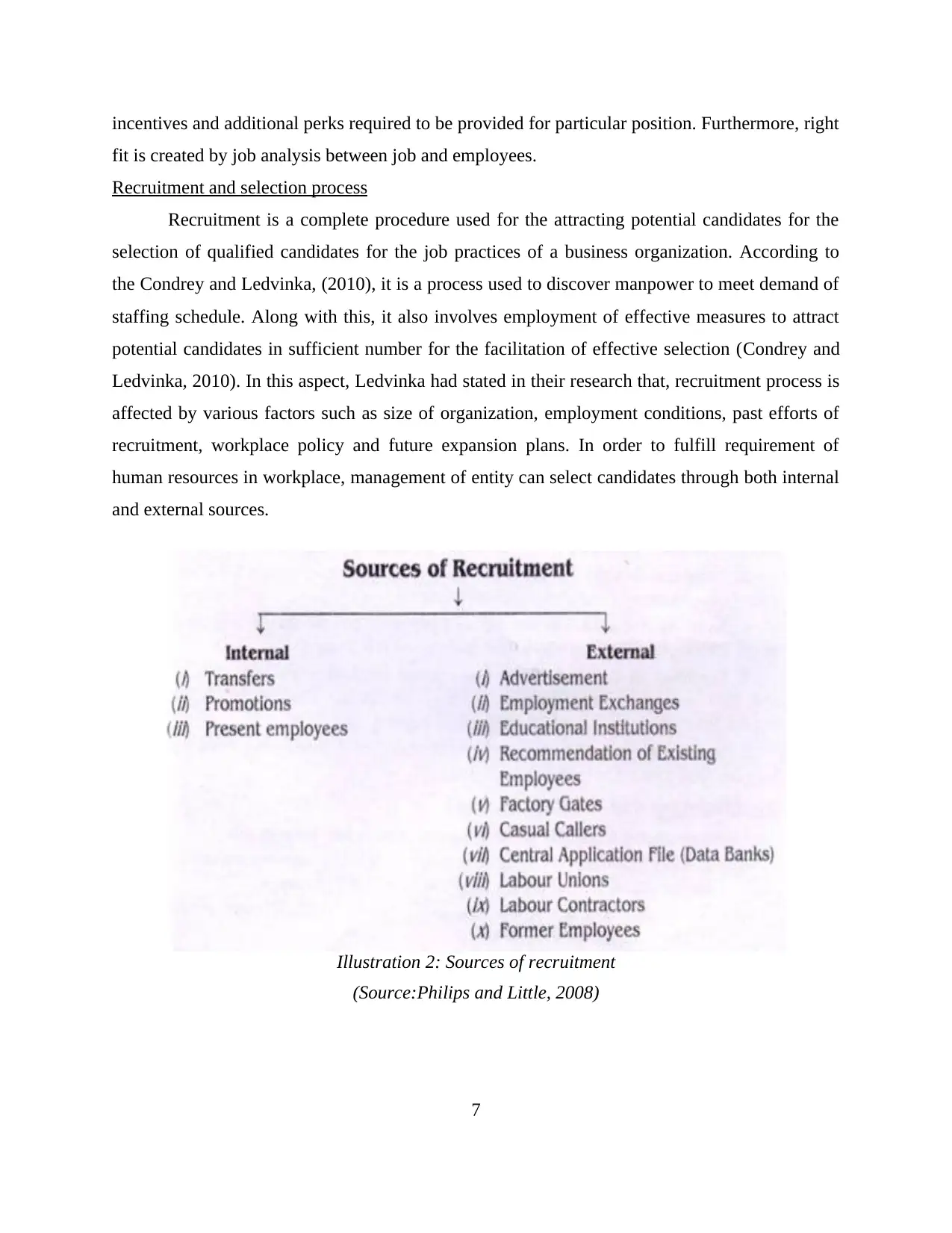
incentives and additional perks required to be provided for particular position. Furthermore, right
fit is created by job analysis between job and employees.
Recruitment and selection process
Recruitment is a complete procedure used for the attracting potential candidates for the
selection of qualified candidates for the job practices of a business organization. According to
the Condrey and Ledvinka, (2010), it is a process used to discover manpower to meet demand of
staffing schedule. Along with this, it also involves employment of effective measures to attract
potential candidates in sufficient number for the facilitation of effective selection (Condrey and
Ledvinka, 2010). In this aspect, Ledvinka had stated in their research that, recruitment process is
affected by various factors such as size of organization, employment conditions, past efforts of
recruitment, workplace policy and future expansion plans. In order to fulfill requirement of
human resources in workplace, management of entity can select candidates through both internal
and external sources.
7
Illustration 2: Sources of recruitment
(Source:Philips and Little, 2008)
fit is created by job analysis between job and employees.
Recruitment and selection process
Recruitment is a complete procedure used for the attracting potential candidates for the
selection of qualified candidates for the job practices of a business organization. According to
the Condrey and Ledvinka, (2010), it is a process used to discover manpower to meet demand of
staffing schedule. Along with this, it also involves employment of effective measures to attract
potential candidates in sufficient number for the facilitation of effective selection (Condrey and
Ledvinka, 2010). In this aspect, Ledvinka had stated in their research that, recruitment process is
affected by various factors such as size of organization, employment conditions, past efforts of
recruitment, workplace policy and future expansion plans. In order to fulfill requirement of
human resources in workplace, management of entity can select candidates through both internal
and external sources.
7
Illustration 2: Sources of recruitment
(Source:Philips and Little, 2008)
Paraphrase This Document
Need a fresh take? Get an instant paraphrase of this document with our AI Paraphraser
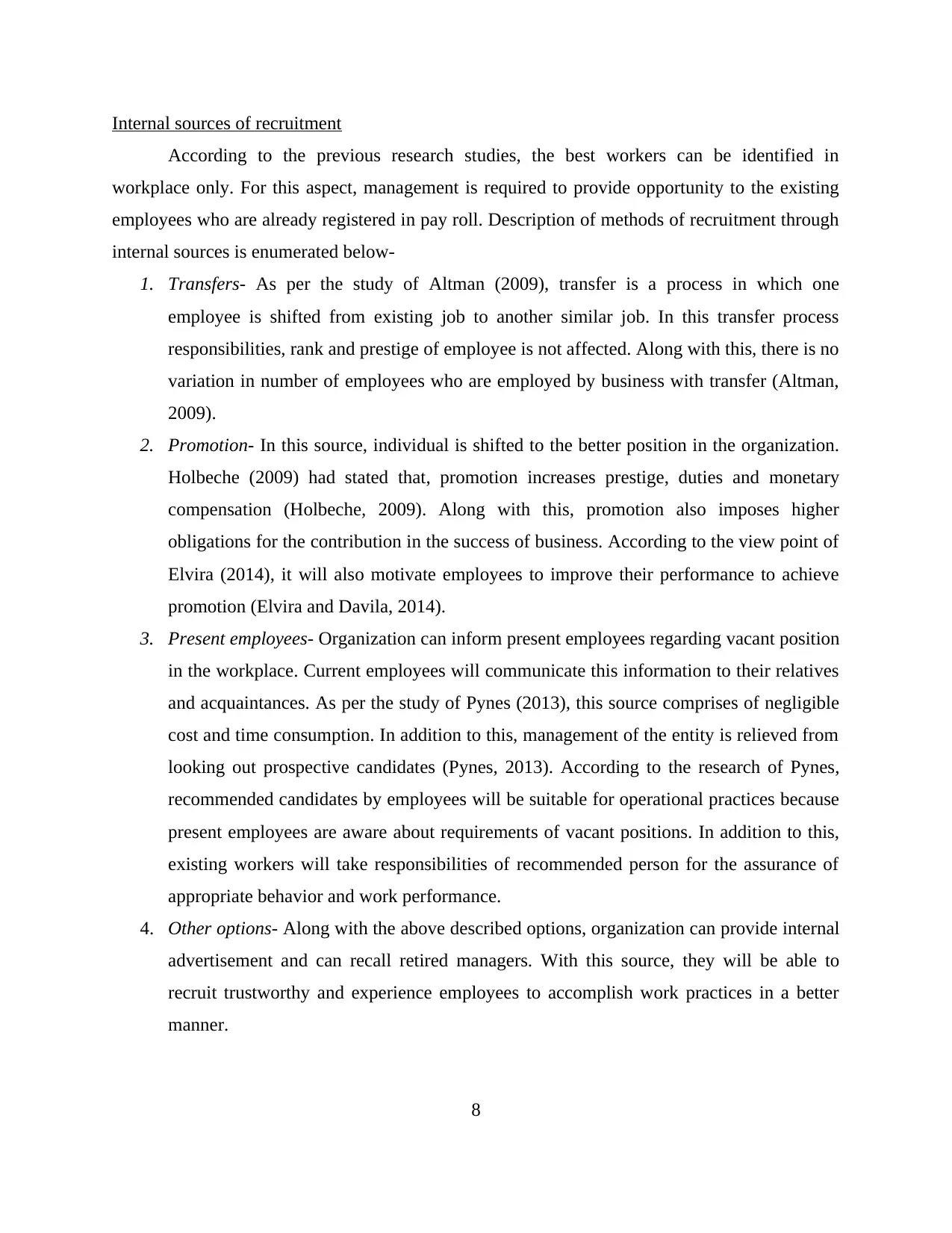
Internal sources of recruitment
According to the previous research studies, the best workers can be identified in
workplace only. For this aspect, management is required to provide opportunity to the existing
employees who are already registered in pay roll. Description of methods of recruitment through
internal sources is enumerated below-
1. Transfers- As per the study of Altman (2009), transfer is a process in which one
employee is shifted from existing job to another similar job. In this transfer process
responsibilities, rank and prestige of employee is not affected. Along with this, there is no
variation in number of employees who are employed by business with transfer (Altman,
2009).
2. Promotion- In this source, individual is shifted to the better position in the organization.
Holbeche (2009) had stated that, promotion increases prestige, duties and monetary
compensation (Holbeche, 2009). Along with this, promotion also imposes higher
obligations for the contribution in the success of business. According to the view point of
Elvira (2014), it will also motivate employees to improve their performance to achieve
promotion (Elvira and Davila, 2014).
3. Present employees- Organization can inform present employees regarding vacant position
in the workplace. Current employees will communicate this information to their relatives
and acquaintances. As per the study of Pynes (2013), this source comprises of negligible
cost and time consumption. In addition to this, management of the entity is relieved from
looking out prospective candidates (Pynes, 2013). According to the research of Pynes,
recommended candidates by employees will be suitable for operational practices because
present employees are aware about requirements of vacant positions. In addition to this,
existing workers will take responsibilities of recommended person for the assurance of
appropriate behavior and work performance.
4. Other options- Along with the above described options, organization can provide internal
advertisement and can recall retired managers. With this source, they will be able to
recruit trustworthy and experience employees to accomplish work practices in a better
manner.
8
According to the previous research studies, the best workers can be identified in
workplace only. For this aspect, management is required to provide opportunity to the existing
employees who are already registered in pay roll. Description of methods of recruitment through
internal sources is enumerated below-
1. Transfers- As per the study of Altman (2009), transfer is a process in which one
employee is shifted from existing job to another similar job. In this transfer process
responsibilities, rank and prestige of employee is not affected. Along with this, there is no
variation in number of employees who are employed by business with transfer (Altman,
2009).
2. Promotion- In this source, individual is shifted to the better position in the organization.
Holbeche (2009) had stated that, promotion increases prestige, duties and monetary
compensation (Holbeche, 2009). Along with this, promotion also imposes higher
obligations for the contribution in the success of business. According to the view point of
Elvira (2014), it will also motivate employees to improve their performance to achieve
promotion (Elvira and Davila, 2014).
3. Present employees- Organization can inform present employees regarding vacant position
in the workplace. Current employees will communicate this information to their relatives
and acquaintances. As per the study of Pynes (2013), this source comprises of negligible
cost and time consumption. In addition to this, management of the entity is relieved from
looking out prospective candidates (Pynes, 2013). According to the research of Pynes,
recommended candidates by employees will be suitable for operational practices because
present employees are aware about requirements of vacant positions. In addition to this,
existing workers will take responsibilities of recommended person for the assurance of
appropriate behavior and work performance.
4. Other options- Along with the above described options, organization can provide internal
advertisement and can recall retired managers. With this source, they will be able to
recruit trustworthy and experience employees to accomplish work practices in a better
manner.
8
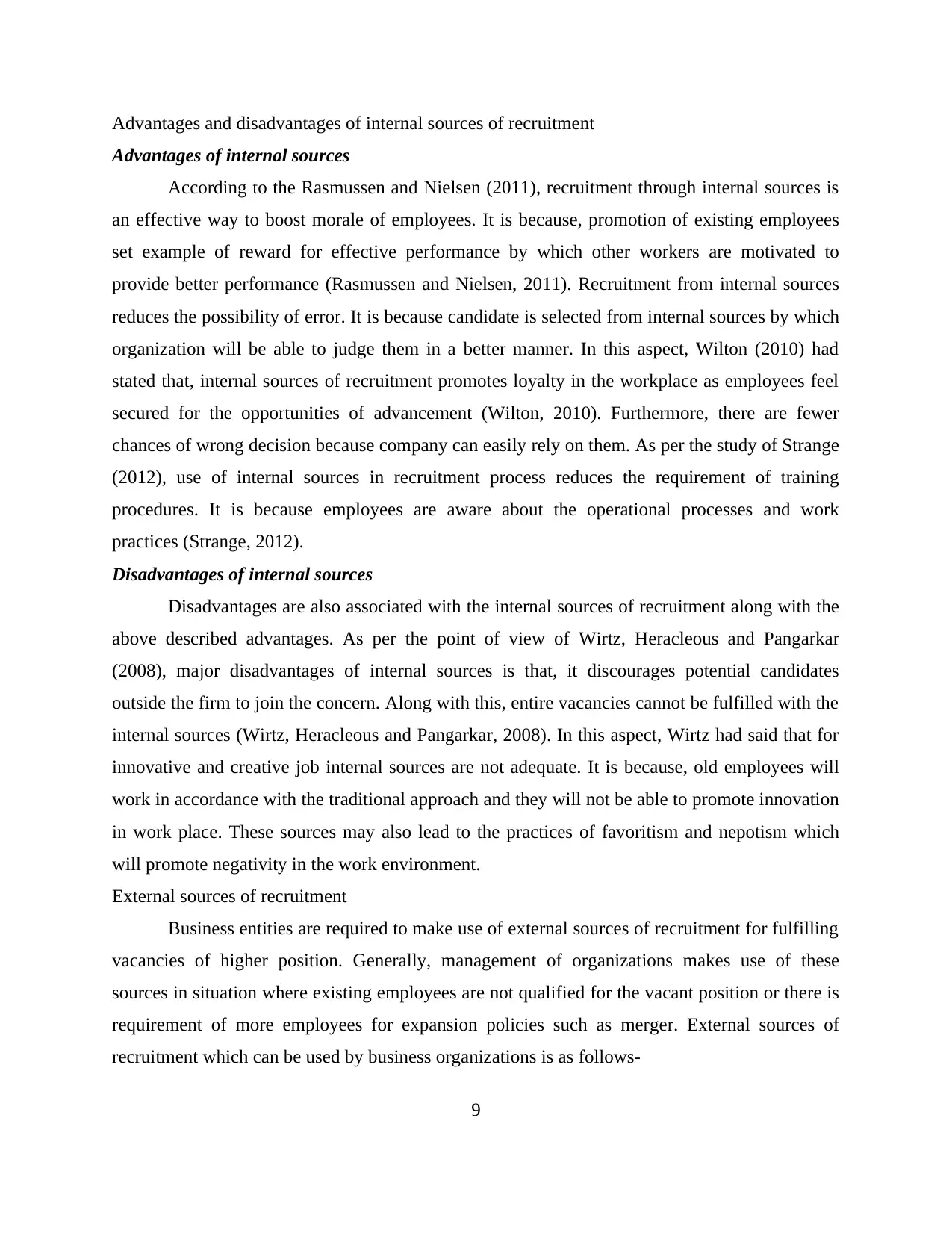
Advantages and disadvantages of internal sources of recruitment
Advantages of internal sources
According to the Rasmussen and Nielsen (2011), recruitment through internal sources is
an effective way to boost morale of employees. It is because, promotion of existing employees
set example of reward for effective performance by which other workers are motivated to
provide better performance (Rasmussen and Nielsen, 2011). Recruitment from internal sources
reduces the possibility of error. It is because candidate is selected from internal sources by which
organization will be able to judge them in a better manner. In this aspect, Wilton (2010) had
stated that, internal sources of recruitment promotes loyalty in the workplace as employees feel
secured for the opportunities of advancement (Wilton, 2010). Furthermore, there are fewer
chances of wrong decision because company can easily rely on them. As per the study of Strange
(2012), use of internal sources in recruitment process reduces the requirement of training
procedures. It is because employees are aware about the operational processes and work
practices (Strange, 2012).
Disadvantages of internal sources
Disadvantages are also associated with the internal sources of recruitment along with the
above described advantages. As per the point of view of Wirtz, Heracleous and Pangarkar
(2008), major disadvantages of internal sources is that, it discourages potential candidates
outside the firm to join the concern. Along with this, entire vacancies cannot be fulfilled with the
internal sources (Wirtz, Heracleous and Pangarkar, 2008). In this aspect, Wirtz had said that for
innovative and creative job internal sources are not adequate. It is because, old employees will
work in accordance with the traditional approach and they will not be able to promote innovation
in work place. These sources may also lead to the practices of favoritism and nepotism which
will promote negativity in the work environment.
External sources of recruitment
Business entities are required to make use of external sources of recruitment for fulfilling
vacancies of higher position. Generally, management of organizations makes use of these
sources in situation where existing employees are not qualified for the vacant position or there is
requirement of more employees for expansion policies such as merger. External sources of
recruitment which can be used by business organizations is as follows-
9
Advantages of internal sources
According to the Rasmussen and Nielsen (2011), recruitment through internal sources is
an effective way to boost morale of employees. It is because, promotion of existing employees
set example of reward for effective performance by which other workers are motivated to
provide better performance (Rasmussen and Nielsen, 2011). Recruitment from internal sources
reduces the possibility of error. It is because candidate is selected from internal sources by which
organization will be able to judge them in a better manner. In this aspect, Wilton (2010) had
stated that, internal sources of recruitment promotes loyalty in the workplace as employees feel
secured for the opportunities of advancement (Wilton, 2010). Furthermore, there are fewer
chances of wrong decision because company can easily rely on them. As per the study of Strange
(2012), use of internal sources in recruitment process reduces the requirement of training
procedures. It is because employees are aware about the operational processes and work
practices (Strange, 2012).
Disadvantages of internal sources
Disadvantages are also associated with the internal sources of recruitment along with the
above described advantages. As per the point of view of Wirtz, Heracleous and Pangarkar
(2008), major disadvantages of internal sources is that, it discourages potential candidates
outside the firm to join the concern. Along with this, entire vacancies cannot be fulfilled with the
internal sources (Wirtz, Heracleous and Pangarkar, 2008). In this aspect, Wirtz had said that for
innovative and creative job internal sources are not adequate. It is because, old employees will
work in accordance with the traditional approach and they will not be able to promote innovation
in work place. These sources may also lead to the practices of favoritism and nepotism which
will promote negativity in the work environment.
External sources of recruitment
Business entities are required to make use of external sources of recruitment for fulfilling
vacancies of higher position. Generally, management of organizations makes use of these
sources in situation where existing employees are not qualified for the vacant position or there is
requirement of more employees for expansion policies such as merger. External sources of
recruitment which can be used by business organizations is as follows-
9
You're viewing a preview
Unlock full access by subscribing today!
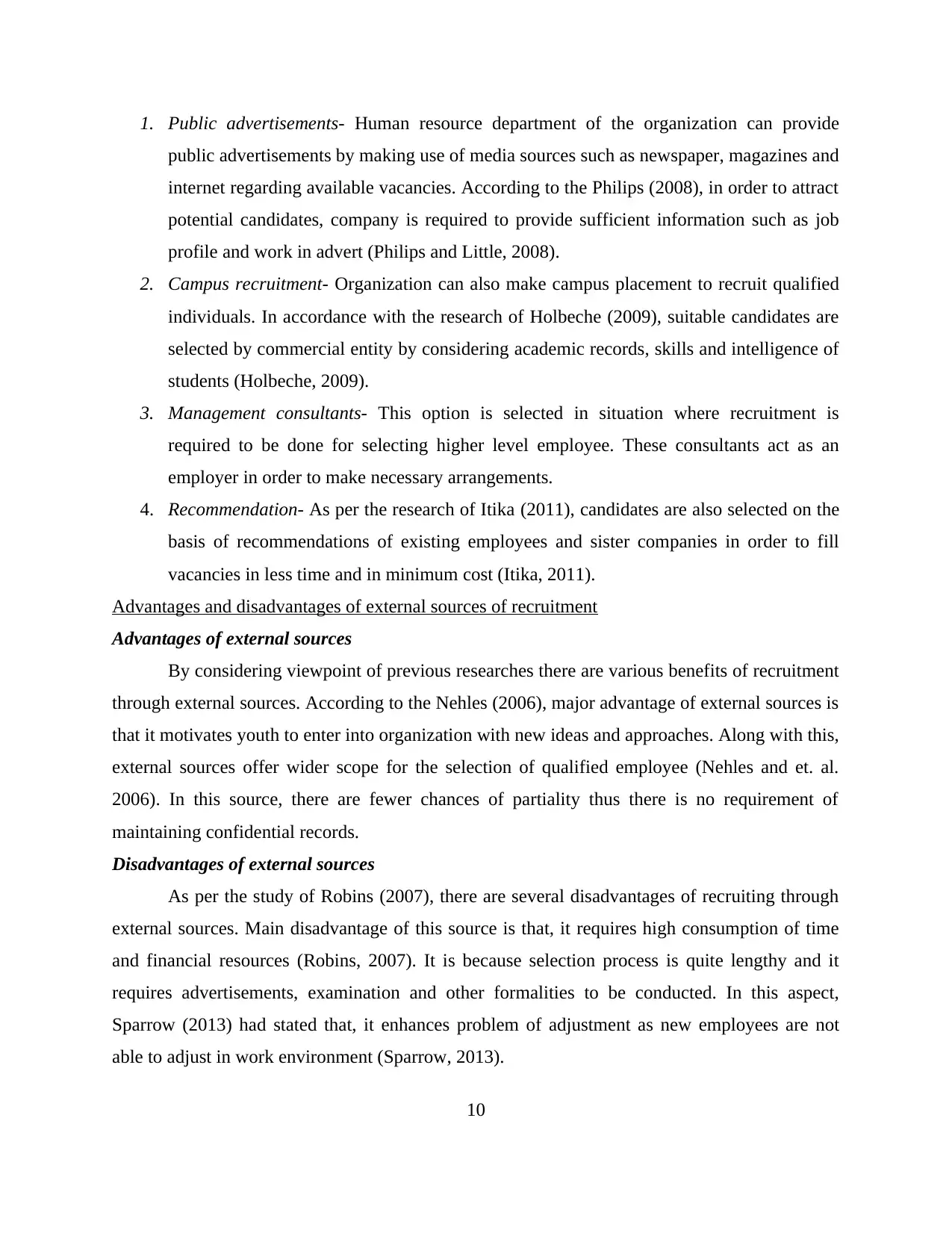
1. Public advertisements- Human resource department of the organization can provide
public advertisements by making use of media sources such as newspaper, magazines and
internet regarding available vacancies. According to the Philips (2008), in order to attract
potential candidates, company is required to provide sufficient information such as job
profile and work in advert (Philips and Little, 2008).
2. Campus recruitment- Organization can also make campus placement to recruit qualified
individuals. In accordance with the research of Holbeche (2009), suitable candidates are
selected by commercial entity by considering academic records, skills and intelligence of
students (Holbeche, 2009).
3. Management consultants- This option is selected in situation where recruitment is
required to be done for selecting higher level employee. These consultants act as an
employer in order to make necessary arrangements.
4. Recommendation- As per the research of Itika (2011), candidates are also selected on the
basis of recommendations of existing employees and sister companies in order to fill
vacancies in less time and in minimum cost (Itika, 2011).
Advantages and disadvantages of external sources of recruitment
Advantages of external sources
By considering viewpoint of previous researches there are various benefits of recruitment
through external sources. According to the Nehles (2006), major advantage of external sources is
that it motivates youth to enter into organization with new ideas and approaches. Along with this,
external sources offer wider scope for the selection of qualified employee (Nehles and et. al.
2006). In this source, there are fewer chances of partiality thus there is no requirement of
maintaining confidential records.
Disadvantages of external sources
As per the study of Robins (2007), there are several disadvantages of recruiting through
external sources. Main disadvantage of this source is that, it requires high consumption of time
and financial resources (Robins, 2007). It is because selection process is quite lengthy and it
requires advertisements, examination and other formalities to be conducted. In this aspect,
Sparrow (2013) had stated that, it enhances problem of adjustment as new employees are not
able to adjust in work environment (Sparrow, 2013).
10
public advertisements by making use of media sources such as newspaper, magazines and
internet regarding available vacancies. According to the Philips (2008), in order to attract
potential candidates, company is required to provide sufficient information such as job
profile and work in advert (Philips and Little, 2008).
2. Campus recruitment- Organization can also make campus placement to recruit qualified
individuals. In accordance with the research of Holbeche (2009), suitable candidates are
selected by commercial entity by considering academic records, skills and intelligence of
students (Holbeche, 2009).
3. Management consultants- This option is selected in situation where recruitment is
required to be done for selecting higher level employee. These consultants act as an
employer in order to make necessary arrangements.
4. Recommendation- As per the research of Itika (2011), candidates are also selected on the
basis of recommendations of existing employees and sister companies in order to fill
vacancies in less time and in minimum cost (Itika, 2011).
Advantages and disadvantages of external sources of recruitment
Advantages of external sources
By considering viewpoint of previous researches there are various benefits of recruitment
through external sources. According to the Nehles (2006), major advantage of external sources is
that it motivates youth to enter into organization with new ideas and approaches. Along with this,
external sources offer wider scope for the selection of qualified employee (Nehles and et. al.
2006). In this source, there are fewer chances of partiality thus there is no requirement of
maintaining confidential records.
Disadvantages of external sources
As per the study of Robins (2007), there are several disadvantages of recruiting through
external sources. Main disadvantage of this source is that, it requires high consumption of time
and financial resources (Robins, 2007). It is because selection process is quite lengthy and it
requires advertisements, examination and other formalities to be conducted. In this aspect,
Sparrow (2013) had stated that, it enhances problem of adjustment as new employees are not
able to adjust in work environment (Sparrow, 2013).
10
Paraphrase This Document
Need a fresh take? Get an instant paraphrase of this document with our AI Paraphraser
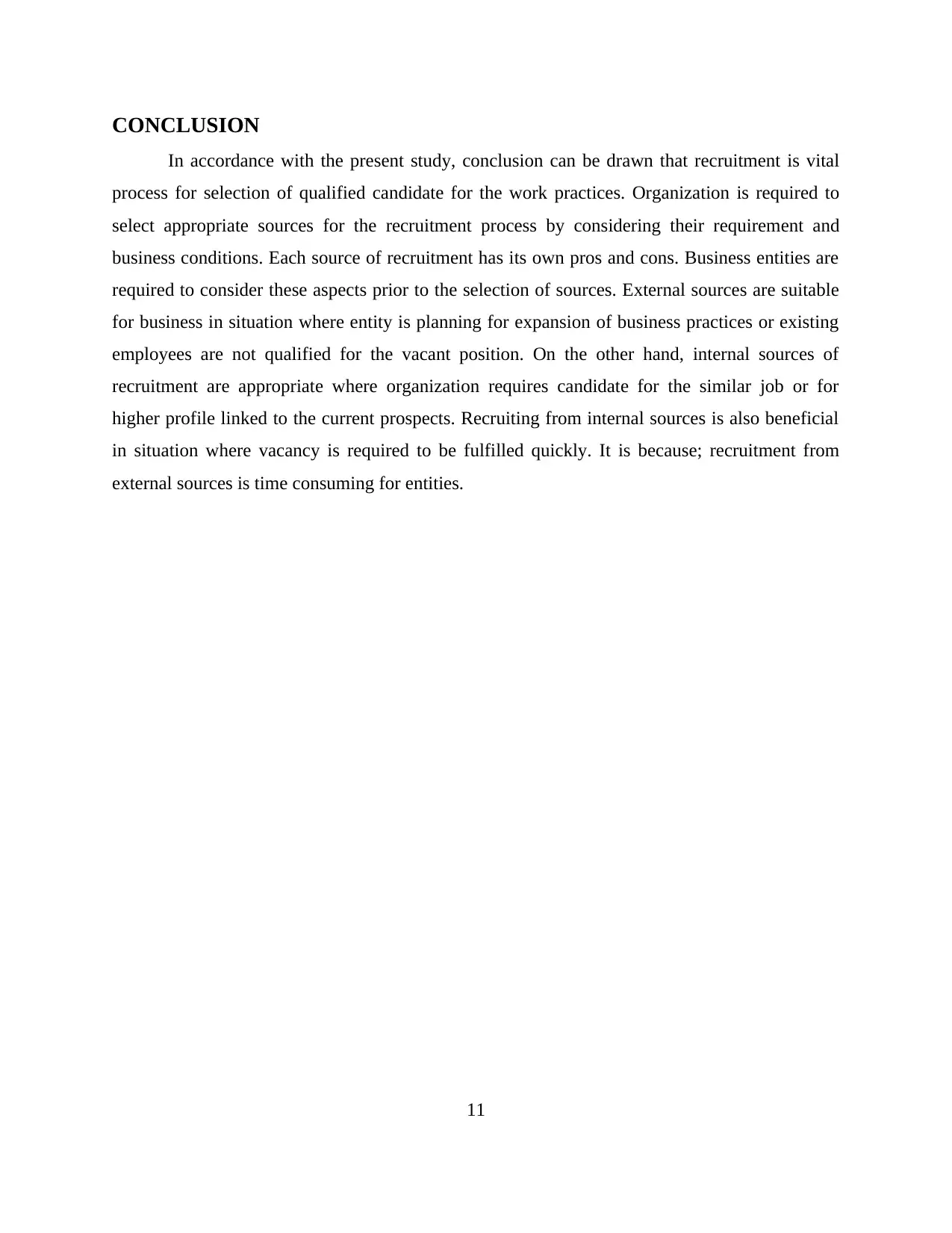
CONCLUSION
In accordance with the present study, conclusion can be drawn that recruitment is vital
process for selection of qualified candidate for the work practices. Organization is required to
select appropriate sources for the recruitment process by considering their requirement and
business conditions. Each source of recruitment has its own pros and cons. Business entities are
required to consider these aspects prior to the selection of sources. External sources are suitable
for business in situation where entity is planning for expansion of business practices or existing
employees are not qualified for the vacant position. On the other hand, internal sources of
recruitment are appropriate where organization requires candidate for the similar job or for
higher profile linked to the current prospects. Recruiting from internal sources is also beneficial
in situation where vacancy is required to be fulfilled quickly. It is because; recruitment from
external sources is time consuming for entities.
11
In accordance with the present study, conclusion can be drawn that recruitment is vital
process for selection of qualified candidate for the work practices. Organization is required to
select appropriate sources for the recruitment process by considering their requirement and
business conditions. Each source of recruitment has its own pros and cons. Business entities are
required to consider these aspects prior to the selection of sources. External sources are suitable
for business in situation where entity is planning for expansion of business practices or existing
employees are not qualified for the vacant position. On the other hand, internal sources of
recruitment are appropriate where organization requires candidate for the similar job or for
higher profile linked to the current prospects. Recruiting from internal sources is also beneficial
in situation where vacancy is required to be fulfilled quickly. It is because; recruitment from
external sources is time consuming for entities.
11
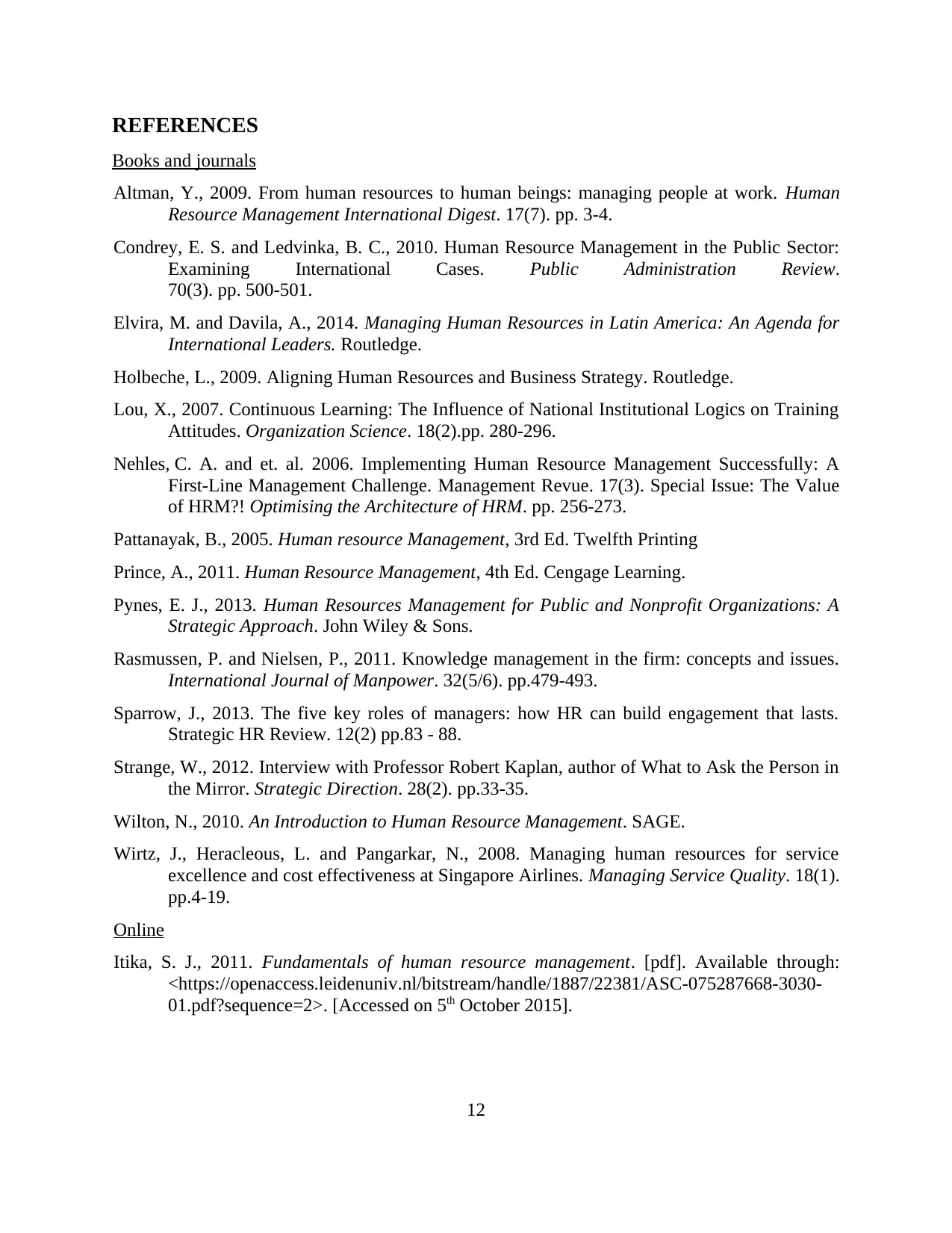
REFERENCES
Books and journals
Altman, Y., 2009. From human resources to human beings: managing people at work. Human
Resource Management International Digest. 17(7). pp. 3-4.
Condrey, E. S. and Ledvinka, B. C., 2010. Human Resource Management in the Public Sector:
Examining International Cases. Public Administration Review.
70(3). pp. 500-501.
Elvira, M. and Davila, A., 2014. Managing Human Resources in Latin America: An Agenda for
International Leaders. Routledge.
Holbeche, L., 2009. Aligning Human Resources and Business Strategy. Routledge.
Lou, X., 2007. Continuous Learning: The Influence of National Institutional Logics on Training
Attitudes. Organization Science. 18(2).pp. 280-296.
Nehles, C. A. and et. al. 2006. Implementing Human Resource Management Successfully: A
First-Line Management Challenge. Management Revue. 17(3). Special Issue: The Value
of HRM?! Optimising the Architecture of HRM. pp. 256-273.
Pattanayak, B., 2005. Human resource Management, 3rd Ed. Twelfth Printing
Prince, A., 2011. Human Resource Management, 4th Ed. Cengage Learning.
Pynes, E. J., 2013. Human Resources Management for Public and Nonprofit Organizations: A
Strategic Approach. John Wiley & Sons.
Rasmussen, P. and Nielsen, P., 2011. Knowledge management in the firm: concepts and issues.
International Journal of Manpower. 32(5/6). pp.479-493.
Sparrow, J., 2013. The five key roles of managers: how HR can build engagement that lasts.
Strategic HR Review. 12(2) pp.83 - 88.
Strange, W., 2012. Interview with Professor Robert Kaplan, author of What to Ask the Person in
the Mirror. Strategic Direction. 28(2). pp.33-35.
Wilton, N., 2010. An Introduction to Human Resource Management. SAGE.
Wirtz, J., Heracleous, L. and Pangarkar, N., 2008. Managing human resources for service
excellence and cost effectiveness at Singapore Airlines. Managing Service Quality. 18(1).
pp.4-19.
Online
Itika, S. J., 2011. Fundamentals of human resource management. [pdf]. Available through:
<https://openaccess.leidenuniv.nl/bitstream/handle/1887/22381/ASC-075287668-3030-
01.pdf?sequence=2>. [Accessed on 5th October 2015].
12
Books and journals
Altman, Y., 2009. From human resources to human beings: managing people at work. Human
Resource Management International Digest. 17(7). pp. 3-4.
Condrey, E. S. and Ledvinka, B. C., 2010. Human Resource Management in the Public Sector:
Examining International Cases. Public Administration Review.
70(3). pp. 500-501.
Elvira, M. and Davila, A., 2014. Managing Human Resources in Latin America: An Agenda for
International Leaders. Routledge.
Holbeche, L., 2009. Aligning Human Resources and Business Strategy. Routledge.
Lou, X., 2007. Continuous Learning: The Influence of National Institutional Logics on Training
Attitudes. Organization Science. 18(2).pp. 280-296.
Nehles, C. A. and et. al. 2006. Implementing Human Resource Management Successfully: A
First-Line Management Challenge. Management Revue. 17(3). Special Issue: The Value
of HRM?! Optimising the Architecture of HRM. pp. 256-273.
Pattanayak, B., 2005. Human resource Management, 3rd Ed. Twelfth Printing
Prince, A., 2011. Human Resource Management, 4th Ed. Cengage Learning.
Pynes, E. J., 2013. Human Resources Management for Public and Nonprofit Organizations: A
Strategic Approach. John Wiley & Sons.
Rasmussen, P. and Nielsen, P., 2011. Knowledge management in the firm: concepts and issues.
International Journal of Manpower. 32(5/6). pp.479-493.
Sparrow, J., 2013. The five key roles of managers: how HR can build engagement that lasts.
Strategic HR Review. 12(2) pp.83 - 88.
Strange, W., 2012. Interview with Professor Robert Kaplan, author of What to Ask the Person in
the Mirror. Strategic Direction. 28(2). pp.33-35.
Wilton, N., 2010. An Introduction to Human Resource Management. SAGE.
Wirtz, J., Heracleous, L. and Pangarkar, N., 2008. Managing human resources for service
excellence and cost effectiveness at Singapore Airlines. Managing Service Quality. 18(1).
pp.4-19.
Online
Itika, S. J., 2011. Fundamentals of human resource management. [pdf]. Available through:
<https://openaccess.leidenuniv.nl/bitstream/handle/1887/22381/ASC-075287668-3030-
01.pdf?sequence=2>. [Accessed on 5th October 2015].
12
You're viewing a preview
Unlock full access by subscribing today!
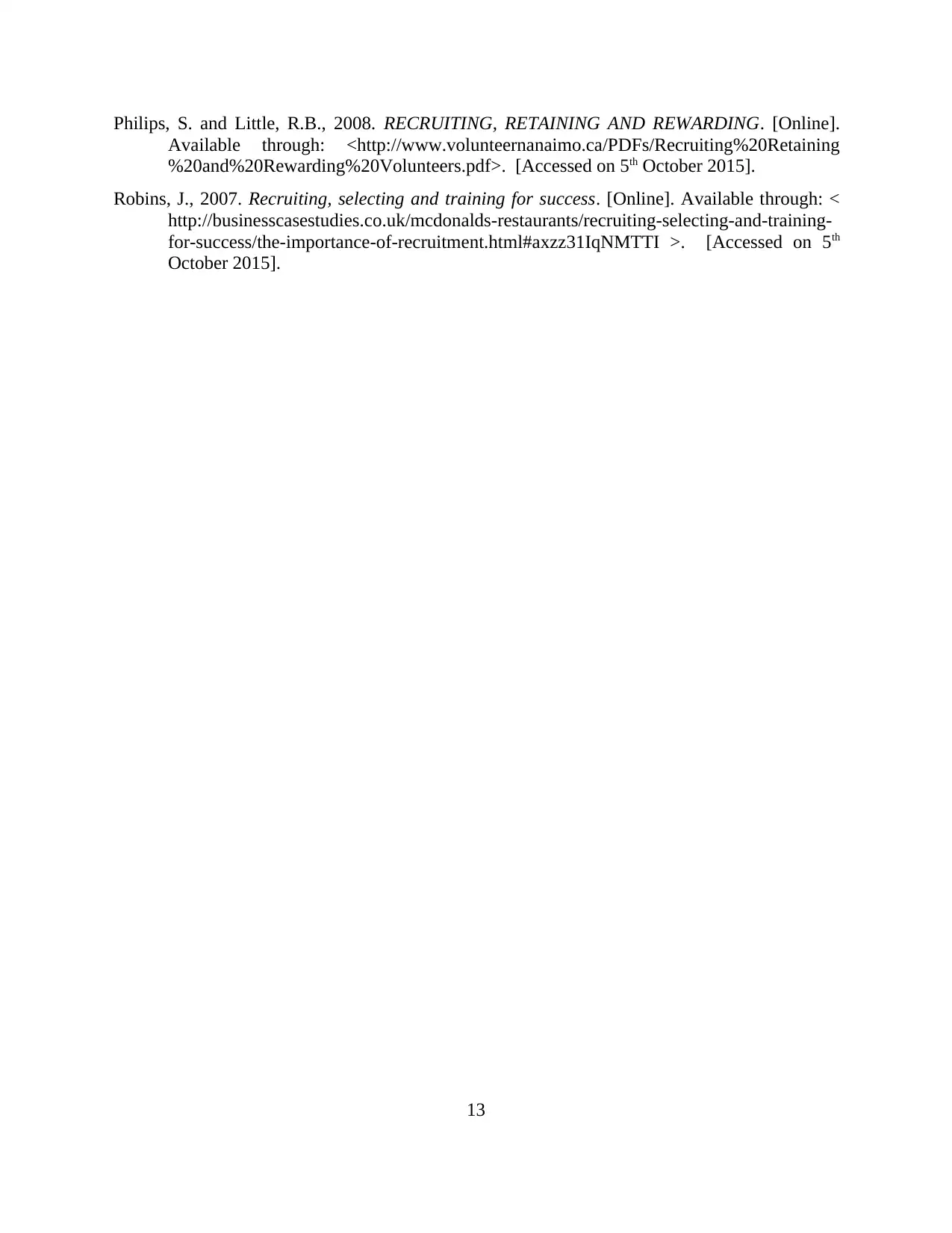
Philips, S. and Little, R.B., 2008. RECRUITING, RETAINING AND REWARDING. [Online].
Available through: <http://www.volunteernanaimo.ca/PDFs/Recruiting%20Retaining
%20and%20Rewarding%20Volunteers.pdf>. [Accessed on 5th October 2015].
Robins, J., 2007. Recruiting, selecting and training for success. [Online]. Available through: <
http://businesscasestudies.co.uk/mcdonalds-restaurants/recruiting-selecting-and-training-
for-success/the-importance-of-recruitment.html#axzz31IqNMTTI >. [Accessed on 5th
October 2015].
13
Available through: <http://www.volunteernanaimo.ca/PDFs/Recruiting%20Retaining
%20and%20Rewarding%20Volunteers.pdf>. [Accessed on 5th October 2015].
Robins, J., 2007. Recruiting, selecting and training for success. [Online]. Available through: <
http://businesscasestudies.co.uk/mcdonalds-restaurants/recruiting-selecting-and-training-
for-success/the-importance-of-recruitment.html#axzz31IqNMTTI >. [Accessed on 5th
October 2015].
13
1 out of 13
Related Documents
Your All-in-One AI-Powered Toolkit for Academic Success.
+13062052269
info@desklib.com
Available 24*7 on WhatsApp / Email
![[object Object]](/_next/static/media/star-bottom.7253800d.svg)
Unlock your academic potential
© 2024 | Zucol Services PVT LTD | All rights reserved.





